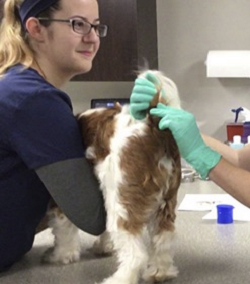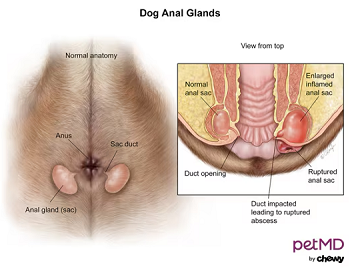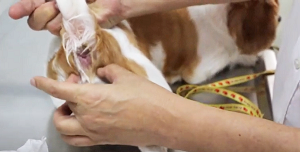Anal Sac Disorders in the Cavalier King Charles Spaniel
-
 What It Is
What It Is - Symptoms
- Diagnosis
- Treatment
- What You Can Do
- Research News
- Related Links
- Veterinary Resources
Cavalier King Charles spaniels have been found to be at increased risk for developing anal sac disorders (ASDs), compared to the average for other breeds. In a July 2021 article, investigators examined the VetCompass records of 104,212 dogs treated in 110 UK veterinary practices in 2013 and found that the cavalier was the most at-risk breed for ASDs. Anal disorders were over 3 times more prevalant in the cavalier than in the average mixed breed dog, with a prevalence of 14.83%. The King Charles spaniel (English toy spaniel) was close behind in second place, with a prevalence of 13.78%. The breed in third place, the Bichon Frise, had a prevalence of only 7.29%.
What It Is
 Two
anal sacs are under the skin, one on either side of and slightly below the
dog's anus. They contain several anal glands which produce fluid which has a strong, unpleasant
odor. When the dog defecates, the
passing feces squeezes some of the fluid secretions out through each
sac's
opening into a duct leading to the anus, in normal cases.
Two
anal sacs are under the skin, one on either side of and slightly below the
dog's anus. They contain several anal glands which produce fluid which has a strong, unpleasant
odor. When the dog defecates, the
passing feces squeezes some of the fluid secretions out through each
sac's
opening into a duct leading to the anus, in normal cases.
The categories of ASD include impaction, sacculitis, and cancer, all described below.
Causes
There are a variety of possible causes of anal sac disorders:
• The sacs may change their positions if the dog is overweight.
• Soft bowel movements may prevent the sacs from secreting properly.
• Tapeworms and other parasites in the intestines may cause irritation at the anus.
• Physical trauma to the the anal sacs, such as during improper manual expression, causing inflammation.
• Irriation resulting from faulty grooming, such as clipper burns or grooming products.
• Intestinal disorders causing soft or watery bowel movements.
• Foods lacking sufficient fiber.
• Abnormal positioning of the glands -- too far internally or too low.
The most common cause of impaction is poor gastrointestinal health, which results in soft or loose or watery feces.
RETURN TO TOP
Impaction
If the glands do not secrete normally, the contents of the sacs will thicken and cause the sacs to enlarge, becoming "impacted". This is a benign condiction which is the most common anal sac problem. It occurs when the sacs do not empty adequately. As a result, the secretions become thicker, and the sac will become enlarged and uncomfortable.
RETURN TO TOP
Sacculitis
Anal sacculitis is inflammation and possible infection of the anal glands. This is the result of severe impaction of the glands, due to a build-up of pus. Anal sacculitis can progress to the formation of an abscess, when the sac swells with pus, obstructing the sac's opening for the secretion of the. In more severe cases, the sac may rupture, releasing the impacted secretions along with pus and possibly blood.
In a September 2006 article examining the medical records of British dogs diagnosed with anal sac gland carcinoma (ASGC), cavaliers were ranked third (behind English cocker spaniels and springer spaniels) as having a breed pre-disposition to developing ASGC.
RETURN TO TOP
Rupture
Rupture of an anal gland means that the gland has burst open. If a gland has become impacted, blocked, inflammed, or infected, the gland may swell and eventually burst. Ruptures can be very painful and invite infections.
RETURN TO TOP
Cancer
The most common form of cancer of the anal sac is anal sac adenocarcinoma or apocrine gland anal sac adenocarcinoma. Several studies of this form of cancer in cavaliers have been reported. See, e.g., this June 2005 report. In a September 2006 article examining the medical records of British dogs diagnosed with anal sac gland carcinoma (ASGC), cavaliers were ranked third (behind English cocker spaniels and springer spaniels) as having a breed pre-disposition to developing ASGC.
In a January 2009 report, the author states that:
"English Cocker spaniels (and to a lesser extent Springer and Cavalier King Charles spaniels) are at higher risk of developing anal sac tumours than other dogs. This conclusion is based upon the analysis of large numbers of cases of anal sac tumours using data from veterinary pathology laboratories and breed registration data from The British Kennel Club."
See also this January 2013 study. See also this February 2017 article regarding surgical treatment of anal sac adenocarcinoma in a CKCS and other breeds.
RETURN TO TOP
Symptoms
 Symptoms include:
Symptoms include:
• licking the anus
• scooting
• biting of the anus and tail
• reluctance to sit
• reluctance to poop
• localized skin irriation
• painful defecation (dyschezia)
• the continuous sensation of the need to pass stools (tenesmus)
• cries of pain
• swelling and redness of the anal area.
Impacted glands may appear to be enlarged or swollen. Infected or inflammed glands also may appear to be reddened. Ruptured glands will seep pus and fluid and possibly also blood.
Anal sac disorders most likely are painful, with sacculitis causing more pain than does impaction. If the sac abscess ruptures, the degree of pain could be extreme.
RETURN TO TOP
Diagnosis
Veterinarians diagnose anal sac disorders by their symptoms and by visual and manual examinations of the rectum. Cancerous cases will require fine needle aspiration, biopsy (histopathology), and microscopic examination (cytology).
RETURN TO TOP
Treatment
 Initial
treatment involves periodic manual "expression" of the
sacs (see photo at right), which
involves applying pressure to the outside of a sac with the forefinger
of one hand and simultaneously applying pressure to the outside of the
other gland with the thumb of the other hand. Other management includes cleaning
of the sac, antibiotics if they are infected, and dietary changes, such
as adding fiber or psyllium powder.
Initial
treatment involves periodic manual "expression" of the
sacs (see photo at right), which
involves applying pressure to the outside of a sac with the forefinger
of one hand and simultaneously applying pressure to the outside of the
other gland with the thumb of the other hand. Other management includes cleaning
of the sac, antibiotics if they are infected, and dietary changes, such
as adding fiber or psyllium powder.
If an anal gland appears to be swollen or have ruptured, treatment would include cleaning the gland, treating infection with antibiotics, and treating for pain.
For those cases which do not respond favorably to such treatments, surgical removal of the anal sacs (anal sacculectomy) is the next option. Removal of the anal sacs also is the prescribed treatment for cases which include cancerous growths.
The cavalier King Charles spaniel is considered "at increased risk of requiring anal sacculectomy", according to three UK studies which reviewed medical records of dogs treated for anal sac disorders. In a September 2006 article examining the medical records of British dogs diagnosed with anal sac gland carcinoma (ASGC), cavaliers were ranked third (behind English cocker spaniels and springer spaniels) as having a breed pre-disposition to developing ASGC.
In a July 2014 article, in which the records of dogs undergoing anal sacculetomies between 2003 and 2013, the author found that:
"Cavalier King Charles spaniels and Labrador-type dogs were over-represented within this study population. ... the CKCS and Labrador/Labrador crosses were likely to be truly over-represented and may be at increased risk of requiring anal sacculectomy."
See also this January 2013 study. See also this February 2017 article regarding surgical treatment of anal sac adenocarcinoma in a CKCS and other breeds.
RETURN TO TOP
What You Can Do
When you take your cavalier to its general practice veterinarian each year, insist that the vet perform a rectal examination. This is especially important for aging dogs. The vet should look around the anus for signs of swelling, inflammation, infections, impaction, abcesses, rectal stricture (stenoisi), and tumors. If it appears that the glands are impacted, then the vet should proceed to express them.
RETURN TO TOP
Research News
July 2021:
Cavaliers were the most at-risk breed for anal sac disorders in
2013 in the UK.
 In
a
July 2021 article, investigators (Dan G. O'Neill [right],
Anke Hendricks, Jennifer A. Phillips, Dave C. Brodbelt, David B. Church,
Anette Loeffler) examined the VetCompass records of 104,212 dogs treated
in 110 UK veterinary practices in 2013 and found that the cavalier King Charles spaniel
was the most at-risk breed for anal sac disorders (ASDs). Anal disorders were
over 3 times more prevalant in the cavalier as in the average mixed
breed dog, with a prevalence of 14.83%. The King Charles spaniel (English toy spaniel) was close
behind in second place, with a prevalence of 13.78%. The breed in third
place, the Bichon Frise, had a prevalence of only 7.29% .The most common
treatments consisted of antimicrobials and analgesics. Anal sacculectomy
(surgery) was performed in fewer than 1% of cases.
In
a
July 2021 article, investigators (Dan G. O'Neill [right],
Anke Hendricks, Jennifer A. Phillips, Dave C. Brodbelt, David B. Church,
Anette Loeffler) examined the VetCompass records of 104,212 dogs treated
in 110 UK veterinary practices in 2013 and found that the cavalier King Charles spaniel
was the most at-risk breed for anal sac disorders (ASDs). Anal disorders were
over 3 times more prevalant in the cavalier as in the average mixed
breed dog, with a prevalence of 14.83%. The King Charles spaniel (English toy spaniel) was close
behind in second place, with a prevalence of 13.78%. The breed in third
place, the Bichon Frise, had a prevalence of only 7.29% .The most common
treatments consisted of antimicrobials and analgesics. Anal sacculectomy
(surgery) was performed in fewer than 1% of cases.
RETURN TO TOP
RETURN TO TOP
Veterinary Resources
Anal sac tumours of the dog and their response to cytoreductive surgery and chemotherapy. S.G. Emms. Austr. Vet. J. June 2005; doi: 10.1111/j.1751-0813.2005.tb15626.x. Quote: A retrospective study of anal sac tumours without pulmonary metastases, from the author's clinical records for the period July 1989 to July 2002, was conducted to establish the response to treatment with surgery and melphalan chemotherapy. Of 21 dogs [including cavalier King Charles spaniels] with tumours of the anal sacs 19 had apocrine gland adenocarcinomas of anal sac origin, one had a benign papillary cystadenoma and another had a malignant melanoma. Two of the 19 dogs had bilateral anal sac adenocarcinomas. Ten of the 19 dogs with apocrine gland adenocarcinomas of anal sac origin had sublumbar lymphadenopathy. Five dogs were excluded by their owners from recommended treatment. Fourteen dogs with apocrine gland adenocarcinomas of anal sac origin were treated by surgical cytoreduction and chemotherapy with melphalan. Seven of the 14 dogs had regional lymph node metastases. Cytoreduction was by local excision of the anal sac in all 14 dogs and concurrent removal of the sublumbar retroperitoneal lymph nodes in the seven dogs with regional lymph node metastases. The median survival time of dogs with sublumbar nodal metastasis was 20 months and for dogs with tumour localised to the anal sac the median survival time was 29.3 months. There was no difference in median survival of those dogs with sublumbar metastases compared to those without. This study suggests there is a role for melphalan in the treatment of dogs with anal sac adenocarcinoma when combined with cytoreductive surgery, with treatment survival times and the local recurrence rate of the primary tumour comparing favourably with previously published treatment regimes.
Breed, gender and neutering status of British dogs with anal sac gland carcinoma. G. A. Polton, V. Mowat, H. C. Lee, K. A. Mckee, T. J. Scase. Vet. & Comparative Onocology. September 2006; doi: 10.1111/j.1476-5829.2006.00100.x. Quote: This study details the breed, gender and neutering status of a large cohort of British canine patients suffering from histologically confirmed anal sac gland carcinoma [ASGC]. Estimates of the relative risk for the development of this disease attributable to these factors are calculated. To reduce the impact of sampling errors, cases were selected from veterinary histopathology laboratories rather than referral hospital databases, and multiple estimates of the general British canine population were used. The weaknesses of the statistical assumptions made are discussed. There was no evidence to support a gender predisposition for the development of this condition. English cocker spaniels are significantly over-represented, with a mean relative risk estimate of 7.3. ... The data indicated that English cocker spaniels, springer spaniels and cavalier King Charles spaniels exhibited statistically significant probabilities of an increased incidence of ASGC; the cocker spaniels demonstrated absolute consistency across the reference populations, P < 0.001. These three breeds were distinguished and the Fisher’s exact tests repeated so that ‘at-risk’ breeds were excluded from the ‘not-at-risk’ groups. Odds ratios and their 95% confidence intervals were then calculated for the at-risk breeds using the modified groupings (Table 3). The data indicate a marked predisposition for the development of ASGC in English cocker spaniels, with an average odds ratio of 7.3; average odds ratios for springer spaniels and cavalier King Charles spaniels were 2.2 and 2.6, respectively. ... The mean relative risk estimate associated with being neutered was 1.4; the effect of neutering appeared to be more significant in male dogs compared with that in female dogs.
Examining the heritability of anal sac gland carcinoma in cocker spaniels. Gerry Polton. J Sm Animal Prac; Jan 2009;50(1):57. Quote: "English cocker spaniels, and to a lesser extent springer and cavalier King Charles spaniels, are at higher risk of developing anal sac gland tumours than other dogs. ... If colleagues have encountered this tumour in an English cocker spaniel, a springer spaniel or a cavalier King Charles spaniel, it would be of great value to this project if a blood sample and/or the affected patient’s pedigree certificate could be submitted for inclusion in the analyses. ... For further information or to submit blood or pedigrees please contact Gerry Polton at North Downs Specialist Referrals, Friesian Building 3&4, Brewerstreet Dairy Business Park, Brewer Street, Bletchingley, Surrey RH1 4QP, UK. Tel: +44 (0) 1883 741440, Fax: +44 (0) 1883 347030. E-mail: gerrypolton@gmail.com website: www.ndsr.co.uk"
Evaluation of an anal sac adenocarcinoma tumor in a Spitz dog. Javad Javanbakht, Abbas Tavassoli, Atefeh Sabbagh, Mehdy Aghamohammmad Hassan, Shohreh Alian Samakkhah, Radmehr Shafiee, Ali Lakzian, Vahideh Rahmani Ghalee, and Sonia Shoja Gharebagh. Asian Pac J Tropical Biomed. Jan. 2013; 3(1):74-78. Quote: "Anal Gland Adenocarcinoma is a cancer of the apocrine gland, located inside of the anal sac. Canine anal glands are scent glands that produce an oily secretion. They are found on either side of the dog's anus between the internal and external sphincter. These tumors tend to be locally invasive and can metastasize early. However, this cancer is associated with a prolonged clinical course. Breeds more commonly affected include English Cocker Spaniels, Cavalier King Charles Spaniels, German Shepherds and English Springer Spaniels. Both genders of dogs are equally affected. The cause of this tumor is unknown."
Breed-Predispositions to Cancer in Pedigree Dogs. Jane M. Dobson. ISRN Vet.Sci. 2013. Quote: "Cancer is a common problem in dogs and although all breeds of dog and crossbred dogs may be affected, it is notable that some breeds of pedigree dogs appear to be at increased risk of certain types of cancer suggesting underlying genetic predisposition to cancer susceptibility. Although the aetiology of most cancers is likely to be multifactorial, the limited genetic diversity seen in purebred dogs facilitates genetic linkage or association studies on relatively small populations as compared to humans, and by using newly developed resources, genome-wide association studies in dog breeds are proving to be a powerful tool for unravelling complex disorders. This paper will review the literature on canine breed susceptibility to histiocytic sarcoma, osteosarcoma, haemangiosarcoma, mast cell tumours, lymphoma, melanoma, and mammary tumours including the recent advances in knowledge through molecular genetic, cytogenetic, and genome wide association studies. ... In our clinic (Cambridge, UK) ... cavalier King Charles spaniels ... are under-represented [for mast cell tumors]. ... Canine anal sac gland carcinoma (ASGC) is a relatively uncommon malignancy arising from the apocrine glands in the walls of the anal sacs. This tumour is invasive and metastatic in nature and is often associated with a paraneoplastic hypercalcaemia. Although ASGC [anal sac gland carcinoma] may arise in any breed of dog the English cocker spaniel and to a lesser degree other spaniel types (English springer and cavalier King Charles) have been reported to be predisposed to development of this tumour."
Risk factors for postoperative complications following bilateral closed anal sacculectomy in the dog. T. M. Charlesworth. J. Sm. Anim. Pract. July 2014; doi: 10.1111/jsap.12217. Quote: Objectives: To report the complication rate for bilateral closed anal sacculectomy in the dog and to evaluate potential risk factors for the development of postoperative complications. To identify breed groups at risk of requiring anal sacculectomy. Methods: A retrospective review of medical records of dogs undergoing bilateral closed anal sacculectomy between 2003 and 2013. Results: Sixty-two dogs were included in the study of which 32·3% developed mild and self-limiting complications including 14·5% dogs that experienced postoperative defaecatory complications. No dog developed permanent faecal incontinence. Dogs less than 15 kg bodyweight were more likely to develop postoperative complications. Dogs that used gel to distend the anal sac were more likely to have postoperative complications than those that did not. Previous abscess formation, recurrent disease and pretreatment with antibiotics had no significant effect on postoperative complication rates. Cavalier King Charles spaniels and Labrador-type dogs were over-represented within this study population. ... the CKCS and Labrador/Labrador crosses were likely to be truly over-represented and may be at increased risk of requiring anal sacculectomy. ... Clinical Significance: Anal sacculectomy is a safe procedure with a relatively high rate of short-term but self-limiting, minor, postoperative complications. Smaller (<15 kg) dogs are more likely to experience postoperative complications but the risk of permanent faecal incontinence is low.
Prevalence of disorders recorded in Cavalier King Charles Spaniels attending primary-care veterinary practices in England. Jennifer F Summers, Dan G O’Neill, David B Church, Peter C Thomson, Paul D McGreevy, David C Brodbelt. Canine Genetics & Epidemiology. April 2015;2:4. Quote: Background: Concerns have been raised over breed-related health issues in purebred dogs, but reliable prevalence estimates for disorders within specific breeds are sparse. Electronically stored patient health records from primary-care practice are emerging as a useful source of epidemiological data in companion animals. This study used large volumes of health data from UK primary-care practices participating in the VetCompass animal health surveillance project to evaluate in detail the disorders diagnosed in a random selection of over 50% of dogs recorded as Cavalier King Charles Spaniels (CKCSs). Confirmation of breed using available microchip and Kennel Club (KC) registration data was attempted. Results: In total, 3624 dogs were recorded as CKCSs within the VetCompass database of which 143 (3.9%) were confirmed as KC-registered via microchip identification linkage of VetCompass to the KC database. 1875 dogs (75 KC registered and 1800 of unknown KC status, 52% of both groups) were randomly sampled for detailed clinical review. Clinical data associated with veterinary care were recorded in 1749 (93.3%) of these dogs. The most common specific disorders recorded during the study period were heart murmur (541 dogs, representing 30.9% of study group), diarrhoea of unspecified cause (193 dogs, 11.0%), dental disease (166 dogs, 9.5%), otitis externa (161, 9.2%), conjunctivitis (131, 7.4%) and anal sac infection (129, 7.4%). The five most common disorder categories were cardiac (affecting 31.7% of dogs), dermatological (22.2%), ocular (20.6%), gastrointestinal (19.3%) and dental/periodontal disorders (15.2%). Discussion and conclusions: Study findings suggest that many of the disorders commonly affecting CKCSs are largely similar to those affecting the general dog population presented for primary veterinary care in the UK. However, cardiac disease (and MVD in particular) continues to be of particular concern in this breed. Further work: This work highlights the value of veterinary practice based breed-specific epidemiological studies to provide targeted and evidence-based health policies. Further studies using electronic patient records in other breeds could highlight their potential disease predispositions.
Surgical management of primary, metastatic and recurrent anal sac adenocarcinoma in the dog: 52 cases. D. C. Barnes, J. L. Demetriou. J. Sm. Anim. Pract. May 2017;58(5):263-268. Quote: Objectives: To report the outcomes and complications of a cohort of dogs with primary and recurrent anal sac adenocarcinoma managed with surgery as the first-line treatment. To report the use of lymph node cytology for identification of metastatic disease. Methods: Retrospective review of case records of a single referral centre population of dogs diagnosed with anal sac adenocarcinoma. Results: Fifty-two clinical cases were identified [including one cavalier King Charles spaniel]. Altered ultrasonographic appearance of lymph nodes was highly consistent with metastatic disease as assessed by cytology and histopathology. Seven of 58 (12%) perineal surgeries had reported minor complications and seven (12%) others required further surgical intervention. Minor controllable intra-operative bleeding was the only complication noted associated with lymph node extirpation in two of 39 (5%) metastectomy procedures. Six dogs (12%) suffered local recurrence and 22 (42%) developed subsequent or recurrent nodal metastatic disease. From the time of detection of disease recurrence, median additional survival associated with a second surgical intervention was 283 days. Clinical Significance: Coeliotomy for lymph node metastatectomy in dogs with adenocarcinoma of the anal sac has low morbidity and should be considered in patients presenting with evidence of regional metastatic disease both at initial presentation and with recurrent disease.
Non-neoplastic anal sac disorders in UK dogs: Epidemiology and management aspects of a research-neglected syndrome. Dan G. O'Neill, Anke Hendricks, Jennifer A. Phillips, Dave C. Brodbelt, David B. Church, Anette Loeffler. Vet. Rec. July 2021: doi: 10.1002/vetr.203. Quote: Background: Non-neoplastic anal sac disorders (ASD) are frequent presentations for dogs in primary-care practice but evidence-based information on disease occurrence and risk is sparse. This study estimates prevalence, breed associations and other risk factors as well as reporting on clinical management. Methods: A cohort study of dogs attending VetCompass practices between 1 January 2013 and 31 December 2013. Risk factor analysis used multivariable logistic regression methods. Results: Of 104,212 dogs attending 110 UK practices, the 1-year period prevalence of ASD was 4.40% (95% CI: 4.22–4.57). Compared to crossbreds, six breeds showed increased odds of ASD (Cavalier King Charles spaniel, King Charles spaniel, Cockapoo, Shih-tzu, Bichon Frise and Cocker spaniel), and six breeds showed reduced odds (Labrador Retriever, Border collie, Staffordshire Bull Terrier, Lurcher, German Shepherd Dog and Boxer). Brachycephalic types had 2.6 times the odds for ASD compared to dolichocephalic types. Medication prescribed for ASD included antimicrobials (n = 480, 20.24%) and analgesics (n = 284, 11.97%). Anal sacculectomy was performed in under 1% of cases. ... There is also some limited evidence on breed as a risk factor for ASD. Cavalier King Charles Spaniels were reported with prevalence estimates up to 19% for unspecified anal sac disease. ... The prevalence was well over [three times] the 4.4% level for the Cavalier (14.83%) and King Charles Spaniels (13.78%), while the prevalence was less than half of 4.4% for Boxer (1.53%) and German Shepherd Dog (1.72%). ... Conclusions: High prevalence, strong breed predispositions and evidence of severity suggested from the antimicrobial and analgesic therapies combined with current substantial knowledge gaps identify ASD as a key research-neglected syndrome in dogs.


CONNECT WITH US